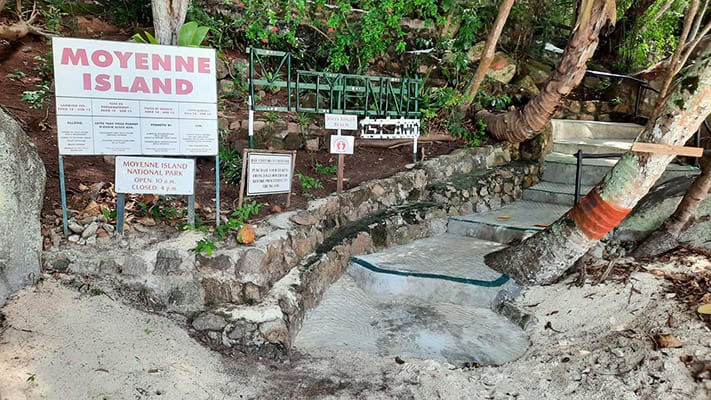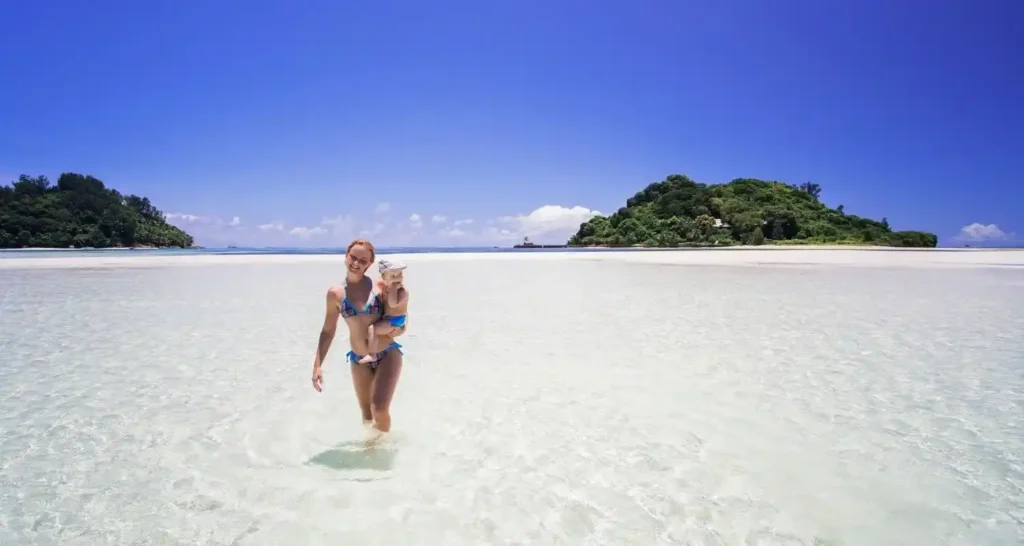At a Glance
- Moyenne Island blends history, wildlife and conservation, offering an intimate escape within the Seychelles.
- Visitors explore forest trails, pirate lore, quiet beaches and roaming Aldabra tortoises on guided trips.
- The island’s caretakers preserve native habitats, supporting sustainable tourism and long-term protection.
Moyenne Island, one of the smallest of the Seychelles’ inner islands, feels like a storybook come to life, a speck of green rising from the turquoise waters of the Inner Seychelles.
It’s a granite island once forgotten, then revived, now preserved as a pocket national park where history, wildlife, and quiet adventure meet.
Barely ten hectares in size, it’s small enough to explore on foot in an afternoon, yet large enough to hold countless stories: pirate graves tucked beneath trees, winding forest trails, a tiny museum, and a slow-moving community of Aldabra giant tortoises that wander freely beneath banyans and boulders.
A legacy by the sea
Moyenne’s modern chapter began in 1962 when Brendon Grimshaw, a Yorkshire newspaperman, bought the island for £8,000. What started as a personal escape turned into a lifelong mission. Together with his Seychellois companion René Antoine Lafortune, Grimshaw spent decades transforming Moyenne, planting over 16,000 trees, carving footpaths, introducing giant tortoises, and tirelessly advocating for its protection.
Their work turned a neglected patch of land into one of the world’s smallest national parks, officially recognised in 2009. Moyenne was so adorable that a Saudi prince offered Brendon $50 million, but he refused. After Grimshaw’s passing in 2012, the Moyenne Island Foundation and local caretakers continued his dream, ensuring the island remained a sanctuary for both nature and memory.

A small island with a big heart
Nestled within the Sainte Anne Marine National Park just north of Mahé, Moyenne measures less than 0.1 square kilometres, a tiny world surrounded by coral and calm seas. Its shoreline stretches just 1.7 kilometres, yet every metre feels distinct: from sandy coves and lookout points to thick stands of trees planted by Grimshaw and Lafortune.
Though only a 15-minute boat ride from Victoria, Moyenne feels worlds away. As visitors wander the narrow trails, the sounds of the city fade into the rustle of leaves, the crunch of coral sand, and the gentle movement of tortoises crossing the path.
Traces of the past: pirates, pioneers, and a museum
Long before Grimshaw, Moyenne was already whispered about in local folklore. It’s said that pirates once used it as a hideout, and two marked graves on the island still bear the label “pirate graves,” lending an air of mystery to its quiet slopes.
Today, history is told more gently, through a small museum and information centre where visitors can trace Grimshaw’s story and the evolution of the island from ruin to refuge. It’s an unpretentious place, much like the man himself, where the exhibits are personal rather than grand, and the message is one of care and perseverance.

Life returns: Tortoises, birds, and the forest
Moyenne’s most beloved inhabitants are its Aldabra giant tortoises, slow-moving symbols of endurance that wander freely through the forest. Many are descendants of the original group introduced by Grimshaw. Their presence, along with native birds and thriving plant life, reflects decades of patient rewilding.
The island’s caretakers continue to restore native vegetation, control invasive species, and nurture the delicate balance between wild and managed space. Around its shores, coral reefs teem with life, offering snorkelling opportunities that complement the island’s quiet, land-based beauty.

Visiting Moyenne: What to expect
Today, Moyenne welcomes visitors mainly on day trips arranged from Mahé. Most tours include guided walks, a picnic or beach lunch, and snorkelling stops around neighbouring islets. The entry fee, usually part of a broader marine-park tour, helps fund conservation and maintenance efforts.
The island’s simple facilities and natural layout keep experiences intimate. There are no hotels or luxury lounges here, only shaded benches, sandy paths, and the sense of being somewhere lovingly preserved. Visitors are encouraged to book through licensed operators and respect marine-park rules, ensuring the island remains as unspoiled as it feels.
Conservation in practice
As part of the Sainte Anne Marine National Park, Moyenne operates under a careful conservation model. Revenue from tourism supports trail upkeep, tortoise care, habitat restoration, and educational programs. It’s a straightforward equation: the more thoughtfully visitors engage, the better the island thrives.
The Moyenne Island Foundation remains central to this work, balancing tourism with protection and maintaining the ethos Grimshaw established, that conservation should be both practical and personal.

Challenges on the horizon
Even a success story like Moyenne faces challenges. Rising sea levels, invasive species, and growing tourism across the Seychelles test the resilience of small islands like this one. A single storm or introduced pest could shift the ecological balance overnight.
Sustained funding for rangers, biosecurity efforts, and local education will be key to ensuring the island’s continued health. Conservationists often cite Moyenne as a model — but also as a reminder of how fragile progress can be.
Why Moyenne matters
Moyenne Island is more than a tourist stop; it’s proof of what dedication and patience can achieve. What began as one man’s private dream has become a living legacy — a sanctuary where every visitor contributes, however modestly, to its survival.
For travellers, it offers more than beaches and views: it’s a place that tells a story of care, resilience, and quiet human effort. In an age of exclusive private islands, Moyenne stands apart — open, small, and entirely alive with meaning.




